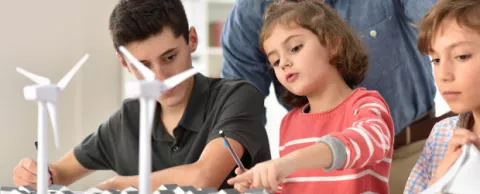
 Getting young people excited about science, technology, engineering and math (STEM) is a positive outcome any way you look at it. Getting them excited about how they can use STEM to solve environmental challenges is better yet. That’s what UL and the North American Association for Environmental Education (NAAEE) are doing with their E-STEM initiative. Read about this year’s winners below – there may be ideas you can replicate in your community. – Philip Bane
Getting young people excited about science, technology, engineering and math (STEM) is a positive outcome any way you look at it. Getting them excited about how they can use STEM to solve environmental challenges is better yet. That’s what UL and the North American Association for Environmental Education (NAAEE) are doing with their E-STEM initiative. Read about this year’s winners below – there may be ideas you can replicate in your community. – Philip Bane
Chicago Botanic Garden’s Science Continuum Curriculum (SCC) was the big winner with its $100,00 Recognition Grant. SCC delivers E-STEM enrichment, mentorship and authentic research opportunities to underserved Chicago Public School students from backgrounds underrepresented in STEM.
The program comprises three components -- Science First, College First and undergraduate internships --and has benefited more than 500 students during its 23-year history. SCC says its replicable model has also demonstrated excellent results. Based on survey responses, since 2008:
- 100% of SCC seniors have graduated from high school
- 95% have matriculated to college
- 93% earned a post-secondary degree
Here’s a quick look at other programs that won UL 2017 Innovative Education awards.
Tier Two $50,000 Recognition Grants
- Boston-based Design Squad Global (DSG) connects kids, ages 9-13, from across the globe to engineer solutions to needs in their communities including protecting the environment, making children's and older people's lives better, improving their schools and helping people stay healthy and safe. DSG is a production of WGBH, the leading producer of programming for PBS.
- Hurricane Island Center for Science and Leadership in Rockland, Maine is a learning community that integrates science education, applied research, and leadership development to provide hands-on learning opportunities to all ages.
Tier Two $50,000 Recognition Grants
- Chicago Eco House uses sustainability to alleviate poverty in some of the most violent neighborhoods in Chicago. Young people learn about various aspects of sustainability including 3D printing, backyard chickens, urban agriculture, off grid solar, healthy cooking, etc. They are trained to apply these concepts in an entrepreneurial context as they grow flowers and create 3D printed jewelry for sale.
- Calgary-based Re-Energy is a hands-on, experiential learning program of the Green Learning Canada Foundation that engages youth in a process of discovery about energy sources -- and the advantages and disadvantages of renewables vs non-renewables -- and then inspires creativity and problem solving through the building of a working renewable energy technology model: solar ovens, wind turbines, and biogas and hydro generators.
More on this topic:
How UL helps steer young people into high-demand technology jobs
STEM progress? Big jump in girls and minorities taking AP computer science exam
#CCEOST#



